Living in Colorado and saw some black and white birds but are not sure which ones they were?
According to the Colorado Bird Records Committee (CBRC), there are over 500 species of birds in the U.S. state of Colorado. Plenty of those are with black and white plumage.
Examples of black and white birds in Colorado include the state bird lark bunting, black-capped and mountain chickadee, downy and hairy woodpecker, American white pelican, eastern kingbird, and many others.
Some of them, like the black-billed magpie and black-capped chickadee, will stay year-round there, while others, like the lark bunting and American pelican, will migrate south from Colorado when the winter comes.
Black And White Birds In Colorado
Black-billed Magpie

Scientific name: Pica hudsonia
Lifespan: up to 9 years
Wingspan: 24 in
Color: Flashy black and white
Range In Colorado: Year-round residents throughout most of Colorado
Also known as the American magpie, the black-billed magpie is an entertaining mid-sized bird often seen sitting on fence posts and road signs, or flapping across rangelands of western North America.
These black and white birds are year-round residents throughout most of Colorado and are easy to identify by the black heads, chests, backs, and tails, white bellies and shoulders, and blue-green iridescent patches in the wings and tails.
As the name suggests, black-billed magpies have thick and slightly curved black beaks and very long, iridescent green tails.
Although rare among birds, black-billed magpies can locate food using their scent. They are omnivorous and feed on insects, carrion, rodents, eggs, young of other birds, and sometimes small snakes.
Black-billed magpies are very social and extremely noisy birds, living in groups of 5-10 individuals.
Source: NPS & MSU Acoustic Atlas / Jennifer Jerrett, Public domain, via Wikimedia Commons
One of the most interesting behaviors among them is the so-called “funeral.” When one magpie discovers a dead magpie, it will call other magpies. Groups of over 40 magpies might gather and spend 10 to 15 minutes around the cadaver before dispersing and flying off silently.
They mate for life and it might take them up to 40 days to construct a single nest.
Often seen around animals, black-billed magpies will pick ticks from the backs of large mammals, such as deer and moose.
Downy Woodpecker
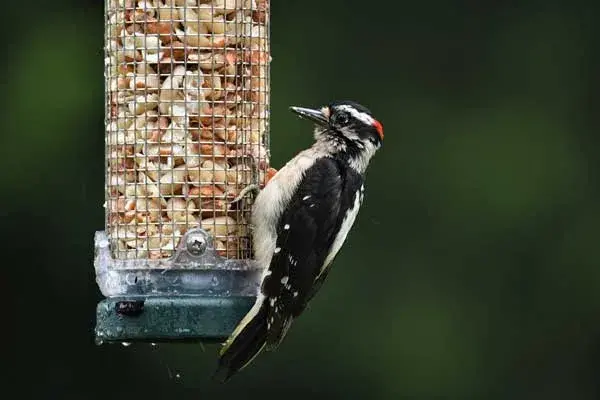
Scientific name: Picoides pubescens
Lifespan: up to 11 years
Wingspan: 10-12 in
Color: Black and white
Range In Colorado: Year-round residents throughout Colorado
A familiar sight at backyard feeders and in parks and woodlots, the downy woodpecker is the smallest species of woodpecker in Colorado (and North America). It can be found throughout the state all year.
To identify it in nature, notice the black color of the upperparts and wings, white back, throat, and belly, and white spottings on the wings. Downy woodpeckers have one white bar above and below the eyes. Adult males have a red patch on the back of the head.
Downy woodpeckers have a soft “pik” call and a rattling sound that starts slowly and speeds up at the end, trailing off.
Source: Jonathon Jongsma, CC BY-SA 3.0, via Wikimedia Commons
They might hit the tree bark over 10 times per second and have special feathers around their nostrils to save them from breathing in wood chips.
Downy woodpeckers are omnivores that mostly feed on insects, beetle larvae, ants, and caterpillars, but also berries, acorns, and grains.
Look for them around bird feeders, they will often eat suet and black oil sunflower seeds and occasionally drink from hummingbird feeders.
Downy woodpeckers are monogamous and the pair will together prepare a nest in the tree. The female will then lay from 3 to 8 eggs.
You can also see these birds if you live in Central Texas.
Hairy Woodpecker
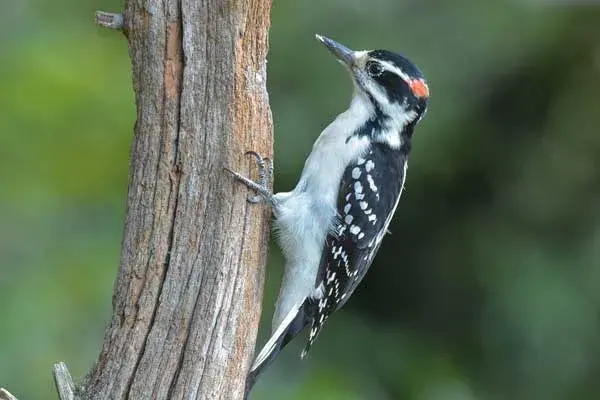
Scientific name: Leuconotopicus villosus
Lifespan: up to 15 years
Wingspan: 13-16 in
Color: Contrastingly black and white
Range In Colorado: Year-round resident throughout Colorado
Similarly looking to downy, the hairy woodpecker is a medium-sized bird that forages along trunks and main branches of large trees. The main difference between the two is the larger size and longer beak in the hairy woodpecker.
Hairy woodpeckers are contrastingly black and white. They have black wings with white patches, two white stripes on the head, and a large white patch down the center of the black back.
The call of hairy woodpeckers is a short and sharp “peek” that is very similar to that of downy woodpeckers.
Source: Jonathon Jongsma, CC BY-SA 3.0, via Wikimedia Commons
They got the name “hairy” because of the thread-like white feathers in the middle of their black backs.
Hairy woodpeckers play an important role in the ecosystem as they eat the insects that destroy forest trees, saving forests as a result. They also eat some berries, seeds, and nuts.
Thick bones and cartilage that act as a shock absorber allow them to hammer at tree back without injuries, and a tongue twice the size of the beak helps probe trees for insects.
Along with the hairy and downy, there are around 10 black and white woodpecker species in Colorado. Those are the red-headed woodpecker, red-bellied woodpecker, Williamson’s sapsucker, Red-naped sapsucker, American three-toed woodpecker, and the Ladder-backed woodpecker.
Lark Bunting
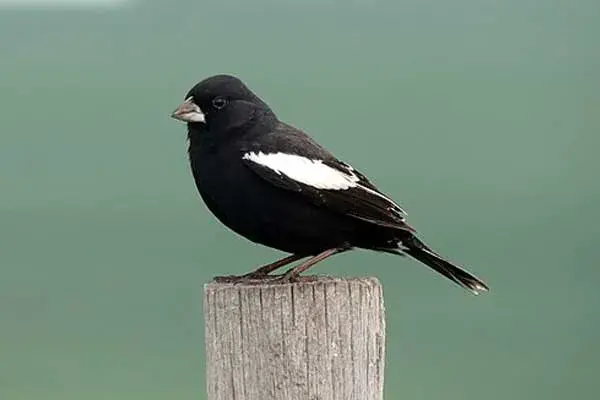
Scientific name: Calamospiza melanocorys
Lifespan: n/a
Wingspan: 10-11 in
Color: Black with white color on the wings
Range In Colorado: Summer resident of eastern and northwestern Colorado
The lark bunting, a state bird of Colorado, is a medium-sized bird common in grasslands of central and western North America.
This black and white bird found in Corado is confusingly named, as it is neither a lark nor a bunting, but a type of large sparrow. Nevertheless, this striking bird epitomized the positivity, optimism, and lively spirit of the state of Colorado and its citizens.
Breeding males have black plumage with white wing patches. When the winter comes, they become grayish brown with small streaks of black and white. Their beaks have a pale blue-gray color.
The bird was selected as a state bird of Colorado due to its acrobatic courtship dance, melodic song, and being native there. Lark buntings hop along the ground when foraging; they walk or run when pursuing prey.
They are omnivores that feed in low areas, eating seeds, insects, and some fruits.
These small and black-and-white-feathered birds begin fall migrations very early, in late July, and arrive in Colorado around April, with flocks from a few dozen to several hundreds of birds.
If you notice an open cup nest in a grassy area, pay close attention as it might be a lark bunting.
Black-capped Chickadee

Scientific name: Poecile atricapillus
Lifespan: 2-3 years
Wingspan: 6-8 in
Color: Gray, black, and white
Range In Colorado: Year-round resident throughout Colorado
This small nonmigratory songbird is a state bird of Massachusetts and Maine in the United States and the provincial bird of New Brunswick in Canada. The black-capped chickadee is unmistakable to spot and is most commonly found in open woods and forest edges.
It has a short neck, large head, black cap and bib, and gray wings that are edged with white patches.
Black-capped chickadees got the name for the black caps on their heads and the distinctive “chickadee-dee-dee” calls. If you hear more “dee” notes, that means the bird is giving you a warning call.
Source: Jonathon Jongsma, CC BY-SA 3.0, via Wikimedia Commons
They are one of the most beloved birds in Colorado and can be found year-round throughout the state.
Black-capped chickadees are one of the more useful birds in the orchard or forest as they eat different pests, including insect eggs, larvae, weevils, lice, sawflies, and also some snails, slugs, and spiders.
Pairs are usually monogamous and may remain together for several breeding seasons. In the early spring, the male will even feed the female.
Mountain Chickadee

Scientific name: Poecile gambeli
Lifespan: up to 10 years
Wingspan: 7.5 in
Color: Gray, black, and white
Range In Colorado: Year-round residents in western and central Colorado
Similar to black-capped, the mountain chickadee is a small black and white songbird found in Colorado, among other states. It is a year-round resident in the western and south-central parts of the state.
As the name suggests, these birds can be found in the mountains, among conifer forest trees. Mountain chickadees are not always easy to spot as they often feed high in the trees. They have black caps, white cheeks, and black throats.
Mountain chickadees are very vocal.
Identify them by their whistled “fee-bee” song, usually with more than one “fee” and more than one “bee” note compared to other chickadees. Their call is a “chick-a-dee” used when chasing competition, communicating with their flock, or when mobbing predators.
Source: Matthias Sirch, CC BY-SA 4.0, via Wikimedia Commons
These fast and agile birds will hop through twigs while looking for food and their diet mostly consists of insects, seeds, and berries.
Mountain chickadees are monogamous birds that build their nests in cavities and have an average clutch size of 5 to 9 eggs.
Gray Jay

Scientific name: Perisoreus canadensis
Lifespan: 8 years
Wingspan: 18 in
Color: Gray, black, and white
Range In Colorado: Year-round resident in central and western parts of Colorado
Known as the Canada Jay from the 19th century until 1957, the gray jay is a stocky and fairly large songbird. It has a short beak, round head, long tail, and broad, rounded wings.
Often found in small groups, gray jays live year-round on permanent territories in coniferous and mixed forests. When winter comes, their thick and fluffy plumage will puff up and cover their legs and feet.
The oldest gray jay recorded in Colorado had 17 years and two months. It was banded in 1985 and recaptured and re-released in 2002.
They usually glide slowly but will enter a fast, maneuverable flight mode when running away from a predator or settling territorial disputes with other jays.
Gray jays are monogamous and stay with their mates as long as both birds are alive, rarely leaving each other’s sides.
They are omnivorous and feed on arthropods, berries, carrion, nestling birds, and fungi.
Gray jays have a song that consists of a series of soft melodious notes interspersed with quiet clicks. They also have several calls ranging from harsh chatters to clear whistles.
Source: Jonathon Jongsma, CC BY-SA 4.0, via Wikimedia Commons
Northern Goshawk

Scientific name: Accipiter gentilis
Lifespan: up to 6 years
Wingspan: 40-47 in
Color: Dark slate gray, black, and white
Range In Colorado: Year-round resident in central and western parts of Colorado
In Colorado, northern goshawks are found in the forested mountains across the state. They build their nests in quaking aspen, ponderosa pine, lodgepole pine, and aspen/mixed conifer stand.
It is a species of medium-large raptor and an accipiter, a “true hawk”. Northern goshawks are easy to spot by their broad, rounded wings and long tails. They have dark heads, white eyebrows, faces, throats, breasts, and bellies. The back is blue-gray.
However, if you’re an avid birdwatcher, you will want to identify this bird from a safe distance as it is very aggressive and will swoop and attack anything that comes too close.
Northern goshawks can reach a top speed of 61 mph and will silently wait for their prey before rapidly descending and killing it.
They are carnivores that feed on medium and large-sized birds, snowshoe hares, and squirrels. After a successful hunt, they will easily tear apart the prey with sharp claws and strong curved beaks.
This largest hawk species are monogamous, the female will lay 1 to 5 bluish-white eggs and incubate them, while the male provides her with food during that period.
Identify northern goshawk by their alarm call consisting of a series of rapid “ki-ki-ki” notes.
Source: Alvaro Ortiz Troncoso, CC BY-SA 3.0, via Wikimedia Commons
American Pelican

Scientific name: Pelecanus erythrorhynchos
Lifespan: 16-30 years
Wingspan: 95-120 in
Color: Snowy white with black flight feathers
Range In Colorado: Summer resident in eastern Colorado
The American white pelican is a large aquatic bird that lives in inland shallow freshwater lakes, wet prairies, and marshes in the summer, and on coastal lagoons in the winter.
It has white plumage and black flight feathers visible only when the wings are spread. American pelican also has a vivid yellow-orange bill and legs. They are one of the largest boreal birds and can weigh as much as 30 pounds.
During summer, American white pelicans are a spectacular sight on the reservoirs and lakes of western Colorado.
They are relative newcomers to the state and first arrived there in the 1960s. They breed in CO during summer and in late August or early September they will migrate to Central and South America.
A group of pelicans is called a “brief”.
Want to read more about Colorado’s birds? Check our list of the largest birds found in the state.
Black-necked Stilt
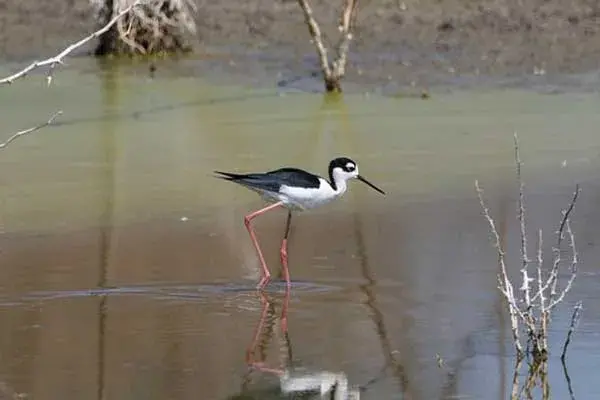
Scientific name: Himantopus mexicanus
Lifespan: 12-20 years
Wingspan: 28-30 in
Color: Glossy black and white
Range In Colorado: Summer resident in southern Colorado
This delicately-looking black and white shorebird is found in southern parts of Colorado during summer where it breeds. Black-necked stilt has a striking black plumage above that is white below, rosy pink legs, and a long thin black bill.
These birds can be found along the edges of shallow water in the open country.
Black-necked stilts got their Latin name as a reference to their long and thin legs. These birds will often wade in shallow waters in search of marine invertebrates and insects.
Black-necked stilts are gregarious birds that often roost in small groups but spread out while foraging.
If you are trying to hear them, listen for a short, squeaky, repetitious yip-yip-yip call.
Source: Jonathon Jongsma, CC BY-SA 3.0, via Wikimedia Commons
Females will lay 3-5 eggs and both partners will take turns and incubate the eggs. After hatching, the young can be seen swimming within two hours.
Clark’s Nutcracker
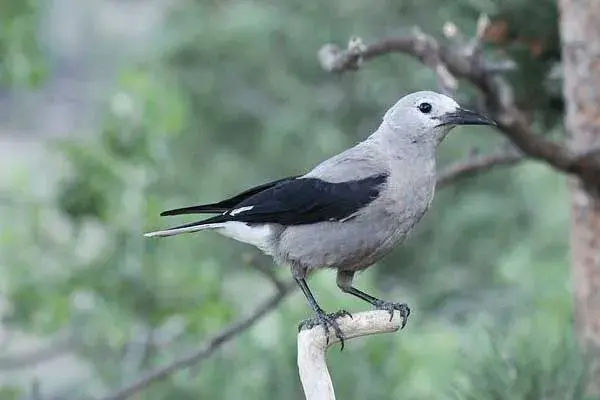
Scientific name: Nucifraga columbiana
Lifespan: up to 17 years
Wingspan: 24 in
Color: Gray, black, and white
Range In Colorado: Year-round resident in western and central parts of Colorado
Clark’s nutcrackers are one of the black and white birds in Colorado that live in the mountain coniferous forests. They are conspicuous birds found at elevations ranging from 3,000 to 12,000 ft.
Clark’s nutcrackers have pale gray plumage and black and flashy white tails and wings. They have long pointed beaks and may resemble woodpeckers in flight – make sure to listen for their noisy grating “kraak” calls as they fly overhead.
Source: NPS / Shan Burson, Public domain, via Wikimedia Commons
Clark’s nutcrackers are omnivores that feed on pine nuts, burying seeds in the ground in the summer and then retrieving them in the winter by memory. They will also eat berries, insects, eggs from other birds, and even carrion.
Clark’s Grebe
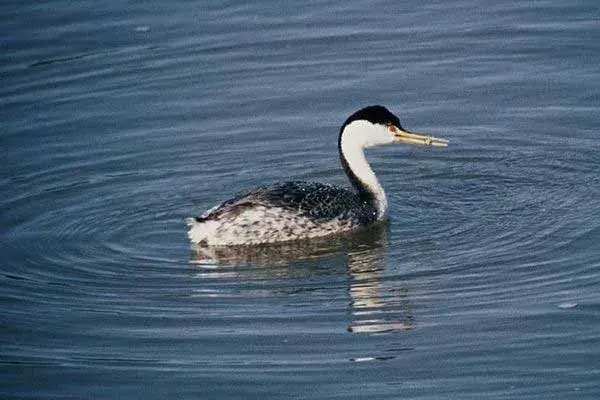
Scientific name: Aechmophorus clarkii
Lifespan: up to 14 years
Wingspan: 23-25 in
Color: Dark gray, black, and white
Range In Colorado: Summer resident throughout Colorado
Similar in size, range, and behavior to the western, Clark’s grebe is a large waterbird with a long, slender neck, a straight yellow-orange beak, and a relatively small body. It has dark gray upperparts, white underparts, and a black top part of the face.
Clark’s grebe is a water-diving bird that feeds on insects, polychaete worms, crustaceans, and salamanders.
These birds are famous for their courtship rituals in which they walk on water.
Both the western and Clark’s grebes will engage in a maneuver called “rushing”, where they sprint for about 7 seconds across the water in groups of two or more. They will take between 14 and 20 steps per second (the fastest humans can do around 5-6 steps), water walking for around 66 feet in total.
You can see how that looks here.
They are semi-monogamous birds that will stay with a single mate, but only for a single season.
Western Grebe

Scientific name: Aechmophorus occidentalis
Lifespan: up to 11 years
Wingspan: 31-40
Color: Crisp black and white
Range In Colorado: Summer resident throughout most of Colorado
One of North America’s most elegant black and white birds found in Colorado, western grebes are the largest species of grebe. They are found around large freshwater lakes and marshes in colonies that may have hundreds of pairs.
Western grebes have a crisp black and white plumage – black head and most of the face with white extending down the neck. They have red eyes and greenish-yellow beaks.
Just like Clark’s, western grebes will participate in the marvelous water dance/race ceremony.
Their plumage is so dense and waterproof that in the 19th century, people were hunting western grebes to make luxury coats, capes, and hats.
Western grebes are carnivores and mostly eat fish. They are aggressive hunters that will dive under the water and spear fish with their long beaks.
Common Goldeneye
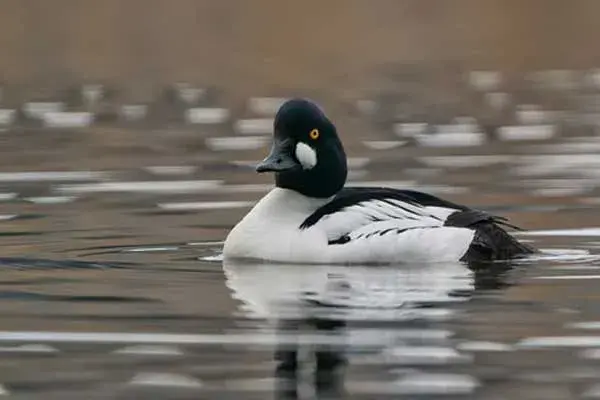
Scientific name: Bucephala clangula
Lifespan: up to 20 years
Wingspan: 30.3-32.7 in
Color: Black and white
Range In Colorado: Winter resident throughout Colorado
This medium-sized sea duck has a large head and a fairly small and narrow beak. Common goldeneyes are mostly black and white. They have black-green heads and crisp black-and-white bodies. The species is named for its golden-yellow eye.
Common goldeneyes generally migrate late in fall and early in spring, in small, loose flocks. They will spend the winter in Colorado, among other states.
In case you decide to go look for them, watch for flocks on fairly large bodies of water, their distinctively shaped heads, and the bright yellow eyes that can be seen from afar.
Common goldeneyes are aggressive and territorial ducks that have elaborate courtship rituals. To seduce a female, males will bend their heads backward to touch their rumps, thrust forward, and kicks up water with their feet.
They are water-diving birds that feed on crustaceans, aquatic insects, and mollusks.
Read More: More examples of ducks that have black and white plumage
Barrow’s Goldeneye

Scientific name: Bucephala islandica
Lifespan: up to 18 years
Wingspan: 28-30 in
Color: Black and white
Range In Colorado: Winter resident in northwest parts of Colorado
This medium-sized sea duck was named after Sir John Barrow, a famous 18th-century explorer.
Adult males are mostly black and white, with bright yellow eyes, and round white spots near the bills. Barrow’s goldeneyes will spend winter in some northwestern parts of Colorado.
They breed on forested lakes and rivers and mainly eat aquatic insects, crustaceans, and pond vegetation.
Barrow’s goldeneyes have a rather long lifespan – the oldest individual ever recorded had 18 years.
Eastern Kingbird
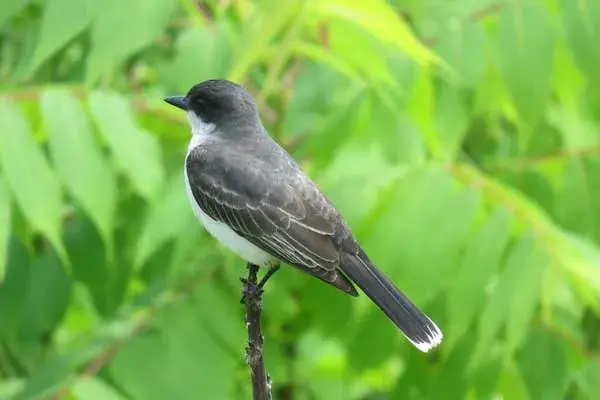
Scientific name: Tyrannus tyrannus
Lifespan: up to 11 years
Wingspan: 13-15 in
Color: Gray-black above and white below
Range In Colorado: Summer resident in western parts of Colorado
Common and easy to spot in western parts of Colorado during summer, the eastern kingbird is easy to identify by the gray-black upperparts, white underbelly, and pointed wings. It is a long-distance migrant that spends winter in South America, primarily western Amazonia.
It often perches out in the open, on tall trees, snags, fences, and utility lines where it is watching for large insects and making quick flights to snatch them. It also feeds on berries and fruit, mainly in the winter habitat.
Eastern kingbirds are very aggressive and if another bird enters their territory, even a larger one, it will attack fiercely. Neither hawks nor crows are safe from them.
If you go searching for these conspicuous birds, listen for their song that consists of high, sputtering notes and their high-pitched “kit-kit” and “dzee-dzee” calls.
Source: Jonathon Jongsma, CC BY-SA 3.0, via Wikimedia Commons
They are also one of the many examples of North Texas birds.
Lesser Scaup
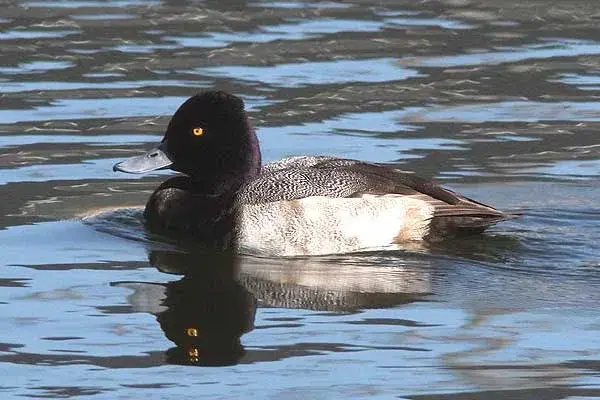
Scientific name: Aythya affinis
Lifespan: up to 18 years
Wingspan: 27-31 in
Color: Black and white
Range In Colorado: Summer resident in northern Colorado
The lesser scaup is a small North American diving duck that migrates south as far as Central America in winter. During summer, this black and white bird can be seen in Northern Colorado.
Look for black and white plumage, iridescent black head (green or purple in the right light), white sides, black rump, and black and white barred back. Lesser scaups also have bluish beaks and yellow eyes. If you live in southern Colorado, you might even see them in winter, as some birds winter in the state.
During migration and winter, lesser scaups will form large flocks on lakes, bays, and rivers. They are the most widespread species of diving ducks in North America, with an estimated population of slightly under 4 million.
Read More: More examples of blue-billed ducks
Northern Shrike

Scientific name: Lanius excubitor
Lifespan: 4 years
Wingspan: 11.8–13.8 in
Color: Gray, black, and white
Range In Colorado: Winter resident in most of Colorado
This fairly large songbird is a big predator of birds, small mammals, and insects. Northern shrikes breed in northern parts of the continent and in winter come as far south as the northern United States.
You will find them in open but brushy habitats, and on sunny days, Northern shrikes may sit up on utility wires, bushes, and trees. Look for gray birds with black masks and black and white wings and tails.
They are nicknamed “butcher birds” since they occasionally hunt more than they can eat and often store food for later by impaling their prey on tree sticks or barbed wire.
Northern shrikes have an extension on their beaks called “tomial tooth”. This is also present in falcons like the peregrine and helps the birds kill their prey quickly.
Loggerhead Shrike
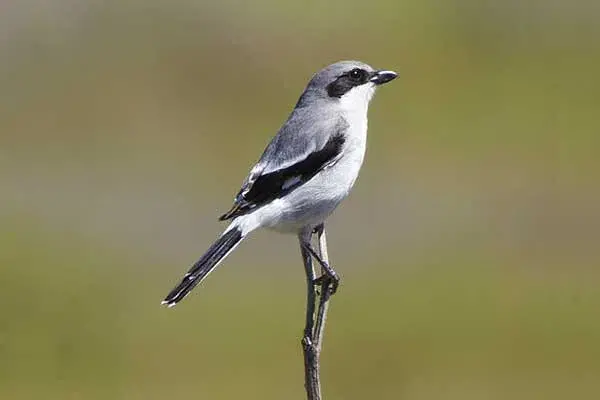
Scientific name: Lanius ludovicianus
Lifespan: 7-8 years
Wingspan: 13 in
Color: Gray, black, and white
Range In Colorado: Summer resident in most of Colorado, present year-round in southern parts of the state
The loggerhead shrike is a songbird with raptor habits. This bird looks similar to the northern shrike and can be found in grasslands and other open habitats throughout much of North America. It breeds during summer in Colorado and from September to November moves south.
The main difference between the Northern and Loggerhead shrike is the loggerhead’s smaller size, darker gray plumage, and larger black face mask that covers the eye completely.
Both species are nicknamed “butcherbirds” after their carnivorous tendencies, and both have a tomial tooth to help tear into prey.
Loggerhead shrikes mostly feed on large insects, rodents, and small birds, sometimes killing prey larger than themselves.
White-throated Swift

Scientific name: Aeronautes saxatalis
Lifespan: up to 10 years
Wingspan: 14 in
Color: Black and white
Range In Colorado: Summer resident in central and western Colorado
White-throated swift, a medium-sized bird that is primarily black and white, can be found during summer in central and western parts of Colorado. In the state, the swift will breed from early May to mid-August, moving south in the fall.
These birds are very social and can be seen in groups in open areas near cliffs, rock faces, or man-made structures, where they roost.
White-throated swifts have a fast and acrobatic flight with sharp turns to catch insects and spiders while flying. They will also forage over agricultural lands and follow harvesting machinery to capture insects disturbed by the equipment.
Common Merganser

Scientific name: Mergus merganser
Lifespan: up to 13 years
Wingspan: 34-37 in
Color: Iridescent green-black and white
Range In Colorado: Year-round in western and winter resident in eastern Colorado
The common merganser is a large fish-eating duck with a sleek body and thin red bill. Males have striking clean white bodies and black-green heads. Females have elegant gray plumage and cinnamon-colored heads with short crests.
In western parts of Colorado, common mergansers will stay year-round, while in the eastern they will come to spend the winter.
These ducks live mainly on freshwater rivers and lakes, so you should look for them sitting on rocks in midstream, disappearing around the bends, or flying along the river. You might spot gulls around them, waiting for the ducks to come to the surface with fish, and then trying to steal their prey.
Common mergansers are the largest of the three merganser species in North America.
Want to see 20+ examples of the world’s largest black birds? Check this article.
Mississippi Kite

Scientific name: Ictinia mississippiensis
Lifespan: 8-11 years
Wingspan: 35 in
Color: Gray, black, and white
Range In Colorado: Summer resident in southeastern parts of Colorado
These small gray-black and white birds of prey can be found in southeastern Colorado during summer. They will migrate to southern subtropical South America in the winter, mostly to Argentina and Brazil in flocks of 20 to 30 birds.
Mississippi kites have narrow, pointed wings, and females are larger than males.
The species is monogamous with rare courtship displays. However, individuals have been seen guarding their partners against competitors. Both parents will incubate the eggs and care for the young.
Mississippi kites are carnivores that mostly feed on insects, frogs, toads, snakes, bats, rodents, small birds, and turtles.
Read more about the 20 largest white birds in the world here.
Snow Bunting
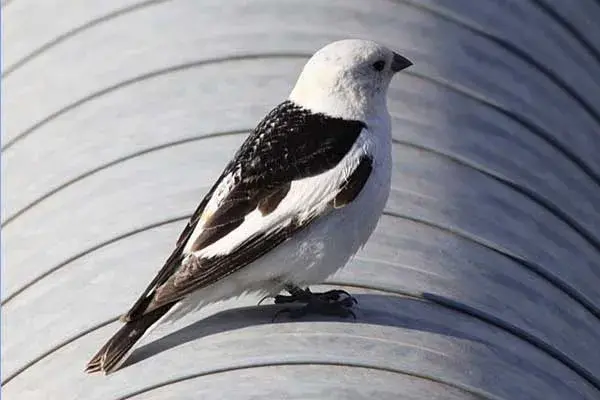
Scientific name: Plectrophenax nivalis
Lifespan: up to 9 years
Wingspan: 13-15 in
Color: Black and snow-white
Range In Colorado: Winter resident in northern Colorado
Snow buntings are medium-sized songbirds with small conical bills. They have black and white plumage – underparts are white and the wings and back have black and white patches on them.
Snow buntings can be occasionally seen in the northeastern part of Colorado during winter but are rare elsewhere in the state. In the winter, they are found around open fields, croplands with grain stubble, shorelines, and roadsides.
Snow buntings breed in the high Arctic, building their nests deep in cracks or other cavities in rocks. This keeps them safe from predators, but the female needs to stay on the eggs to keep them warm for most of the incubation period. Because of that, the male will bring her food almost every 15 minutes.
Identify snow buntings by their finch-like low and husky warble and “chew,” sharp “chi-tik,” and short “buzz” calls.
Source: Vladimir Yu. Arkhipov, Arkhivov, CC BY-SA 3.0, via Wikimedia Commons
Want to learn more about birds with red-colored necks? Check this article.
Dark-eyed Junco
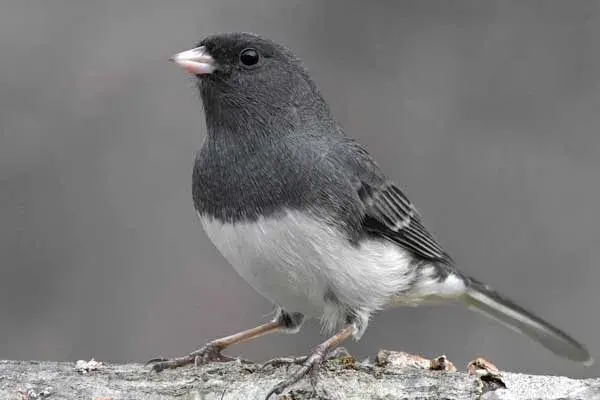
Scientific name: Junco hyemalis
Lifespan: 3-11 years
Wingspan: 9.2 in
Color: Black-gray and white
Range In Colorado: Year-round resident throughout most of Colorado, winter visitors only in far eastern Colorado
This medium-sized sparrow with a rounded head, a short beak, and a fairly long tail can be seen year-round in most parts of Colorado. It is one of the most common birds in North America and will often forage while hopping and running on the ground.
These rosy-billed birds have the nickname “snowbirds” because they’re commonly sighted in winter throughout North America. Dark-eyed juncos mostly feed on seeds, but also insects in summer.
The song of male dark-eyed juncos is a strong musical trill that lasts around two seconds and consists of up to 20 notes.
Both sexes usually have a quieter song that includes different whistles, trills, and warbles. Their calls include high-pitched “chip” and “tick” sounds.
Source: G. McGrane, Public domain, via Wikimedia Commons
Want to learn more about the biggest birds that live in Michigan? Check this article.
Bufflehead
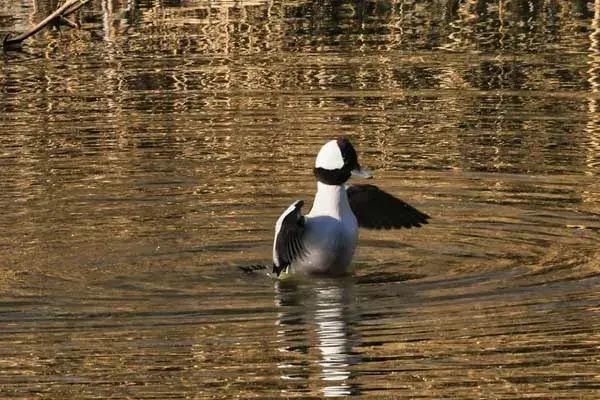
Scientific name: Bucephala albeola
Lifespan: 2.5 years
Wingspan: 22 in
Color: Black and white
Range In Colorado: Winter resident in most parts of Colorado
Bufflehead is a small sea duck with a glossy black-green head, black back, white body, and a large white patch at the back of the head. This black and white bird spends winter in most parts of Colorado.
You will find it spending half the time underwater while foraging. Look for these tiny, black-and-white ducks on inland ponds and sheltered coves.
Buffleheads are monogamous birds, staying with the same partner for many years. These ducks with white heads are omnivorous and feed on aquatic insects, crustaceans, mollusks, and some plants.
Buffleheads are also one of many black and white birds that inhabit Hawaii.
Bonaparte’s Gull
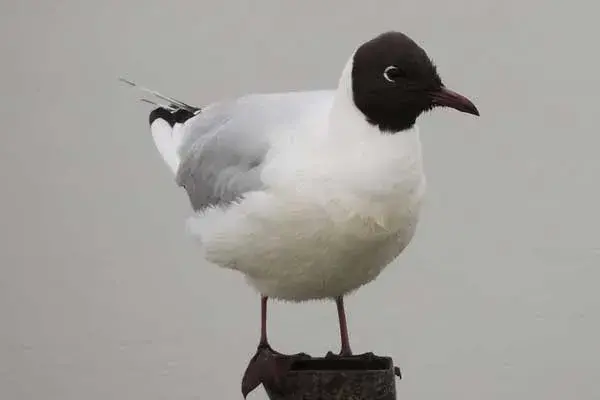
Scientific name: Chroicocephalus philadelphia
Lifespan: up to 18 years
Wingspan: 30-33 in
Color: Black, white, and gray
Range In Colorado: Migrating through most of Colorado
Bonaparte’s gull is a small, tern-like gull, that has a slender beak, pointed wings, and a slim body. Breeding males have black heads and bills, gray backs and wings, and white underparts and tails.
These birds nest in north-central Canada and move east or west towards the nearest coast in the fall. This migration typically starts in late July and lasts through November, so this is your best chance of spotting Bonaparte’s gulls flying over Colorado.
Listen for their most common call which is a scratchy and grating “keh” that can be emitted in series.
Source: Tony Phillips, CC BY 3.0, via Wikimedia Commons
These Colorado’s black and white birds got their name after Charles Lucien Bonaparte, Napoleon Bonaparte’s nephew, who was a leading ornithologist in the 19th century.
Read More: Beautiful black birds with white patches on their wings
Summary
This concludes our list of black and white birds in Colorado.
There are plenty of types of black and white birds in Co, including ducks, grebes, swifts, stilts, pelicans, some kites, several types of woodpeckers, shrikes, and many others.
Colorado has large areas of different natural habitats that make great homes for a wide range of bird species, especially the black-and-white colored ones.
Next time, should you see these birds in person, you should be able to recognize any of them with ease!
And if you enjoyed our article, here are other popular reads on birds: Beautiful blue birds of Pennsylvania and 15 stunning blue birds in Maryland